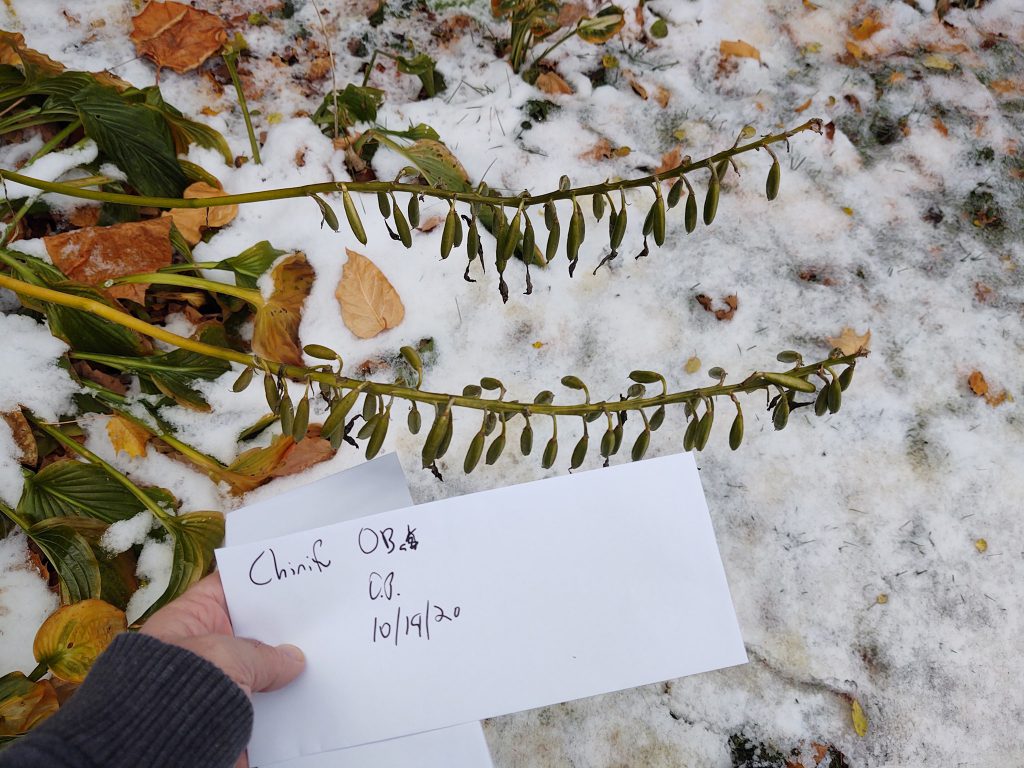As a general rule:
- $5 Per Packet: We try to price most seed packets at $5 each. We think that’s a fair price, yet often see hosta seeds going for significantly more. (If you’re going to spend that much, maybe just by the streaked plant itself?)
- Either 25 or 50 Seeds: For that $5 price, we’ll usually put 25 seeds from streaked parents, or 50 seeds from non-streaked pod parents. But not always…
- Rare/Limited Seeds: In the case of seeds that are of limited quantity or are highly desirable, we may pack fewer seeds per pack and may limit initial purchases of these packs to one per customer, to give the most people a chance to try these seeds. In the case of varieties that produce copious amounts of seed, we may offer them in greater quantities than normal.
- Auctions: In the case of seeds where we maybe only produced a single packet, we may simply offer them at auction, as that’s fairer than simply a “first-come-first-served” sale
About Duluth Hosta’s Seeds
Duluth, Minnesota is pretty far north; we consider our gardens to be zone 3B. As a result, our growing seasons are very short compared to most of the United States. This means that our hostas bloom later, and some cultivars never even make it to blooming before the first snow of the year starts falling.

Seed Harvest
As a result, our seeds are harvested very late in the year, typically early to mid-October and ending towards the start of November. Seed pods are deemed to be ripe when the lower pods start to naturally split, although at times we will also then open the top/last pod on the scape to double check. If the pods are ready they are collected and stored in a paper mailing envelope, with the pod parent and harvest date recorded. The seeds are then stored in our unheated garage, where they further dry and pods split. As we descend into winter, the seeds are exposed to the natural range of freezing temperatures.

Packing and Storing
During the months of November and December, pods are brought inside to be opened, with the seed collected and separated from the chaff, all by hand. Seed cleaning is a family affair, with both our children taking an active role and being well-compensated for their efforts!
When cleaning seeds, some hosta seed grower opt to remove the wing from the hosta seed kernel; this may have an added benefit of reducing the potential for fungal problems during seed sowing. That said, we try to leave the wing intact as it helps readily identify the seed as being from a hosta, as opposed to something else, which would be important should an international shipment require inspection. You can easily remove the wing after receiving your seed, if you desire to do so.
Seeds are then hand-counted and packed into coin envelopes. Everyone has been instructed that if a seed maybe doesn’t look 100%, don’t count it, but you can still include it. Sometimes the color may be off, it may be smaller than most of the seeds in the pod, or it may not feel as plump as some of the other seeds. These seeds still might be good and viable, but we try to not count those towards the total on the packet. It is a bit of a judgment call.
On the back, the seed packet is initialed by the person who counted and packed them (MP or MWP would be Matt Pedersen; E, EP, ETP = Ethan Pedersen; AJ, AJP, AP = Audrey Pedersen). This is the quality control aspect of what we do…”Dad” knows who to hold responsible for a mix-up! 🙂
The front of the packets are once again marked with the pod parent, their pollination status (usually open-pollinated, O.P.), the initial harvest date, and the approximate quantity of seeds in the packet. Generally speaking, this is the minimum quantity of the seeds in the packet; we tend to pack a few extras, just in case. And then, once that’s all done, we do the inventory, return the seeds to cold storage, and put them up for sale.


